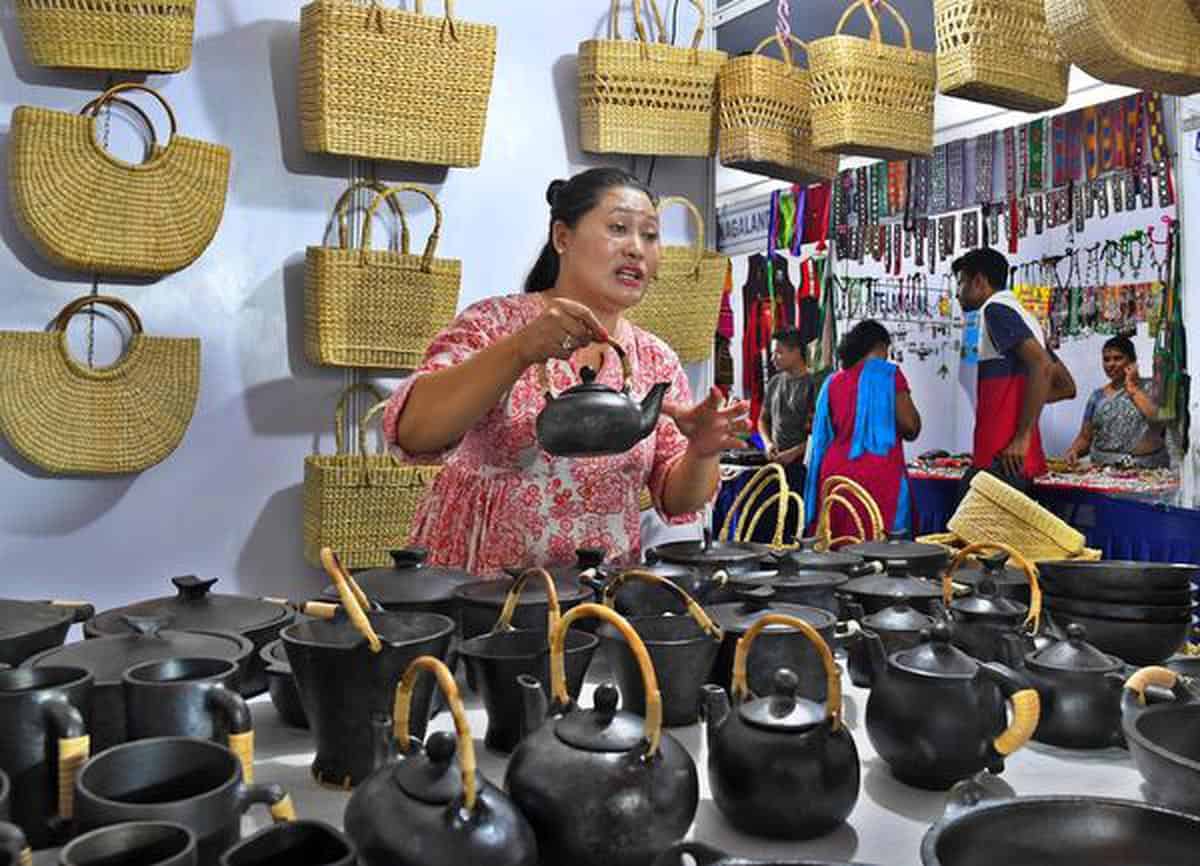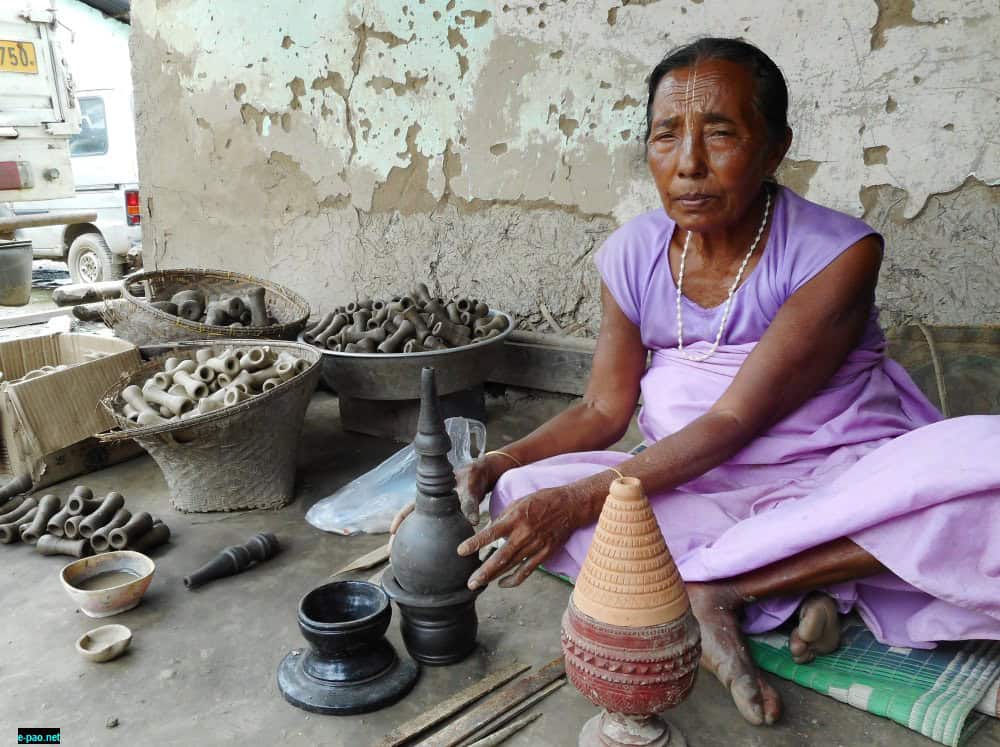A Journey into India’s Dual Heritage of Black Pottery, Where Generations Shape Clay into Art in the Villages of Nizamabad and Longpi.

One of the oldest crafts, the technique of making may be traced back to the beginning of human history. Pottery is not just an art form, but also a combination of the craftsmen’s love, passion, and careful attention to detail in their work. The black version is an example of one of these items.
The black pottery from Uttar Pradesh (northwest) and Manipur (northeast) is the most famous among them. They both have their geographical indications.
Uttar Pradesh Black Pottery
History
The Kutch area of Gujarat is the cradle of this traditional skill. During the reign of Aurangzeb, a number of the region’s most skilled potters made the journey to Nizamabad. The black clay pottery from Nizamabad in Uttar Pradesh is renowned across India for its one-of-a-kind quality. It stands out from other pottery because of its dark and glossy body, which is decorated with etched silver designs.
In December of 2015, it received its registration for the Geographical Indication tag. The clay has a fine texture that is accessible in the area. It is usually practised to engrave designs like geometric patterns and floral themes on them, which adds to their aesthetic appeal. In the city of Nizamabad, there are about 200 families that are involved in the production of black pottery. They focus mostly on selling their goods to nations such as Russia, Australia, and others.
In October 2013, an application for a Geographical Indication (GI) tag was submitted for black clay pottery. This was done with the assistance of the NABARD of Lucknow and the Human Welfare Association of Varanasi. In December of 2015, it was given a GI tag, which allows the owner to restrict the use of the product’s name to a certain geographical area of origin.
Process
Clay extracted from the surrounding area is shaped into the desired forms before being fired in kilns. After that, these items are scrubbed using oil made from mustard seeds and rinsed with vegetable debris. The procedure of etching the motifs is accomplished with the use of sharp twigs.

The next procedure is the one that gives the pottery its distinctive quality; the ware is baked in kilns that are enveloped in a smoking fire that contains rice husks. After that, they are given a second coating of mustard oil before being placed in the oven. The etched designs have silver powder made of zinc and mercury applied to them, then they are cleaned with water, and lastly, if necessary, they are polished with lacquer.
Manipur Black Pottery
History
Manipur is home to a hamlet known as Longpi, which is where the art form of stone or clay pottery gets its name. The Tangkhul Naga tribe are the one that is responsible for this. The wheel of the potter is not used in the production of Longpi pottery! In the state of Manipur, Presley is a member of the Tangkhul Naga tribe, which is centred in the Longpi (or Loree) hamlet. The centuries-old craft of stone ceramics known as Longpi Hamlei has made Longpi a household name.

This kind of pottery is unique to Presley because seven years ago, she and sixteen other women from the village came together to establish a collective known as the “Loree Hamlei” Village Pottery Collective. This collective creates and sells this type of pottery. The Longpi Hamlei brand of cookware has become more well-known throughout India, and it is now being sold at speciality craft shops not just in India but also in other countries.
Process
The raw materials that are utilised are said to be weathered rock and serpentine rock, both of which are accessible in Longpi by themselves, as stated by the locals. The two rocks are ground into a powder before being combined with water in a proportion of 5:3 to produce a substance with the consistency of clay. The dreary mixture is squeezed for the whole of the work day, after which it is smoothed on a wooden board to begin the slab process. Unlike most other types of pottery,
Longpi ware is never made on a wheel. Every object is given its form by hand using a variety of moulds and shaping tools. After the sculpted clay has been allowed to dry out and become sufficiently brittle, it is transferred to an open bonfire where it is burned for five to seven hours at temperatures higher than 1200 degrees centigrade. The pottery is removed from the kiln while it is still hot and then scrubbed with a native leaf that is known as the machee.

This gives the pottery a smooth surface and a lovely lustre. The finished items are dark grey to black cooking pots and kettles, attractive bowls, mugs, and trays, and they are typically complemented by a lacing of fine cane around the handles and knobs. They give off an impression that is both rustic and modern at the same time.
As a result, the primary function of pottery is to facilitate the performance of rites at significant events, such as the marriage of members of the tribe. The only individuals in Manipur who could purchase these potteries were the royal family and the wealthy citizens of the state. In addition to the people of Manipur’s tribal communities, they are also used by the people of Manipur for cooking meals on festive occasions. Vases, plates, pots, saucers, lamps, teapots, bowls, chillum or pipes, incense stick holders, surahi, and statues are just a few of the many different objects that are manufactured for use in the home and as decorative additions.
Where to buy: The Longpi village in Manipur is home to some outstanding examples of black pottery art. Additionally, it may be found in every nook and cranny in the village of Nizamabad in Uttar Pradesh. The design firm Objectry, which was established in Delhi, is responsible for the sale of one of the most impressive works of black pottery art.
Read More: Latest



